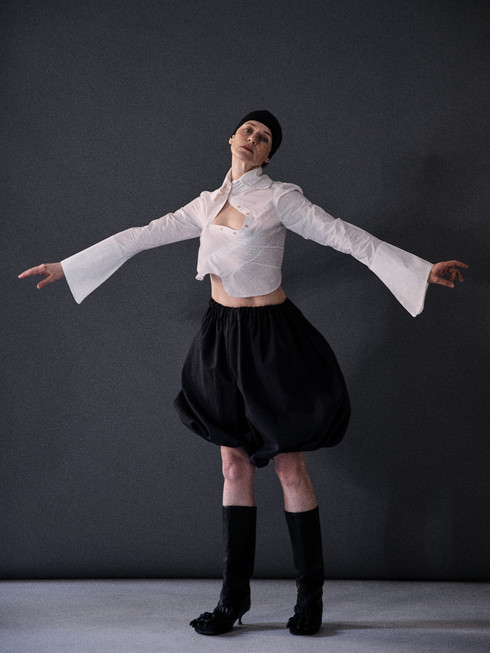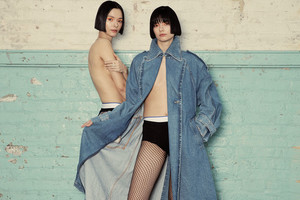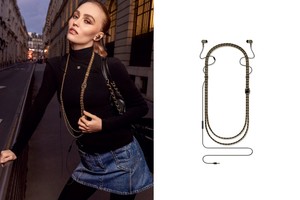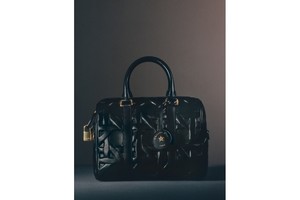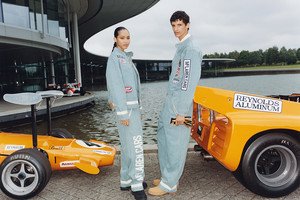Capturing the essence of Sarah Assbring, the woman behind El Perro del Mar, is no small feat. Her singing voice is delicate, almost whispery, while Sarah’s presence carries a certain gravitas, as if her centre of balance lies firmly within herself, and her roots are deeply grounded. Both sides exude a sense of lightness, as well as unshakeable strength. “It's not a persona; rather, it gives me a tool to artistically put myself in a room or a place, that I wouldn't probably be able to if I didn't have the name. It acts as a bit of a cover between me and the public,” she shares, reflecting on the dichotomy between her personal identity and her artistic alias.
Her journey as El Perro del Mar began 20 years ago on a beach in Spain during a time of personal crisis, which she describes as an existential crisis on many levels. She had stopped writing music and singing, but this transformative experience led her back to music, inspired by a stray dog she met on that beach. “I was in a very bad place,” Sarah reflects. “I unconsciously realised I had to break this cycle, so I looked for a cheap flight to anywhere. I ended up on a beach, staring at the ocean, thinking about what to do with my life. A stray dog walked up and sat next to me. The dog's dignity struck me—I felt it had more dignity than I did.” This got her thinking about fundamental things in life - being happy with what you have and appreciating small things. The encounter also served as a catalyst for her debut album, and her slow, step-by-step healing. “I started writing in my diary and eventually started writing music again,” she explains. “The whole debut album was about healing and starting over.”
Sarah's music mirrors her journey, focusing on perspective and appreciating life. “The name El Perro del Mar keeps me grounded both personally and in my music,” she says.
Her latest album, “Big Anonymous,” has a “skinless sincerity,” diving heart-first into losses she has experienced and seeking redemption, almost like an exorcism. “I want to address the things that hurt because I think you can be relieved of the hurt, but you have to address it.”
Sarah's journey as El Perro del Mar is a testament to resilience and the transformative power of art, drawing inspiration from the smallest steps towards healing and the profound impact of perspective.
Natalia Muntean: I read you've been named one of the most consistently intriguing pop artists of the 21st century. How do you relate to that?
Sarah Assbring: Oh, my God! I cannot relate to that. Those are big words. I'm just doing what I do, but it's overwhelming that anyone would say that. I'm constantly on the lookout for something new. It's not about being unhappy with where I am but exploring with curiosity. I tend to grow bored of what I did last, so I seek new platforms and perspectives to discover new things about myself.
NM: Where does El Perro del Mar end and where does Sarah begin?
SA: There's a total separation. El Perro del Mar is about my music, lyrics, and artistic expression. But the deeply personal, intimate part of me remains. It's a means to channel myself into art, though my innermost centre is still present in my music.
NM: Is there a particular song or album that represents your journey?
AS: My debut was definitely a breaking point for me in that I felt like I was able to tap into my core. However, as it was such a painful journey, it’s not a place I want to revisit. I don’t believe in the suffering artist anecdote anymore. Not if you want to live a long and happy life anyway… Even though I’m very proud of all my different albums, Big Anonymous is one of my proudest moments, possibly because it shares the same skinless sincerity and demands beauty despite the darkness as the debut album. And it’s not coming from a dark place.
NM: Did you always know you wanted to sing?
SA: Yes, I was really convinced and stubborn as a young person and when I grew older, whenever I tried to take a different path, music always won. I've always felt quite lost in the world but when it comes to music, it's a natural place where I feel anchored.
NM: What does success mean to you as an artist?
SA: Success means being happy. And feeling creative and feeling like creativity has an endless source.
NM: How do you maintain that endless source of creativity?
SA: Absolutely, I have rituals, often simple ones. Watching films, reading books, and visiting museums — all stir up new ideas and emotions for me. As well as that, never stop working, that's a must. Seeing a really good film can lead me to hearing and planning a new record. It's unlike any other inspiration, multi-dimensional. I love Jonathan Glazer’s work for instance. His ”Zone of Interest” blew me away. I love actors and studying them and their work. It gives such great inspiration just being overtaken by someone else like that.
I love reading too but sadly, I have a harder time getting to that same kind of focus that I get when seeing a really good film. Reading poetry is easier and works in another way for me. I can really recommend Gboyega Odubanjo, for instance, a young British poet who sadly passed away last year.
I always try to find new instruments, like synthesisers and new percussions, for example, seeking sounds that awaken something within me. It's important to keep inspiration and creativity alive by changing environments or routines. It's not difficult, but it needs to be tended to like a garden. When I was younger, I found creativity in feeling bad, heartbroken, or sad. As I’ve lived more, I realise it's better to be happy and not find creativity in destructive things.
MN: Perhaps this idea of the tortured genius may have been promoted more by men? And maybe great art doesn't have to come from suffering.
SA: I totally agree. For me, it's been a wake-up call. Many people I've admired throughout my life had tortured, often short lives. I want to live a long life and be creative until the day I die. I have a melancholic side, and that's always going to be there, so I don't need to worry about losing that. I can always find that place, but the rest of me needs to be taken care of. I've had a tumultuous life with many ups and downs and I've come to realise that I have this vulnerability, and need to take care of myself. If I don't, it will end badly. Especially when I became a mother, it became essential for me to remain stable, not only for my son but for myself. Becoming a mother helped me understand many things about myself. I can be neglectful of myself and not take responsibility, but when I have someone else to take responsibility for, I am better at it.
NM: Has motherhood changed your ambition or need to be more creative?
SA: Before I had my son, I felt like I could work non-stop. My idea of ambition was 100% dedication, but not in a good way. There was an insatiable drive more about feeling loved and validated. Having my son helped me realise that regardless of anything, I am a mother and validated through that. It might sound frail, but it's not. It meant a lot to find balance and realise that even if I'm not productive all the time, I still have value.
NM: Do you think you built yourself up as an artist or were you born this way?
SA: I think of it as something I had for sure. With the risk of sounding pretentious, I absolutely had this thirst for music, for expressing myself, for making things, whatever shape or form very early on. To answer your question, maybe this itch is the truest form of the artist. Where I am now might be a corrupted form of the artist. Some things happen to you along the way when you have a career: self-awareness and experiences you've had, expectations that spin on you, and ways you've been taught to act or look. The more I live, the more I think about my artistry and myself as an artist, and I want to go back to the rawness of the beginning.
NM: I've noticed more women in their 30s or 40s embracing things from their childhood, as a way of getting back to their core selves.
SA: Especially in the line of business I'm in, the pop music business, growing older as a woman is difficult. But there's a freedom in that too, if you just give into it. There's a lot I've been a prisoner of - looking good, being thin, all those superficial things that don't matter. They shouldn't matter, but they do. And many women speak about the freedom they find in growing older and I’m looking forward to that.
NM: To the point of having fewer fucks to give?
SA: Exactly, I'm starting to embrace that. There's so much I disagree with and want to oppose, but it's difficult because you're in constant battle with these ideals and yourself. It's a constant internal battle. I want to be at a place where I embrace it and stay in that place.
NM: Can we talk about your album Big Anonymous? How did you decide on that title?
SA: There's an amazing Swedish writer, named Sara Stridsberg. A few years back, I read all her books and was struck by her way of moving through time and place, between the living and the dead. It started up a process in me that had to do with death and the people I’ve lost in my life, how I keep meeting them in my dreams and felt like the grief and thoughts of death were still very present. Her books reminded me of that. Somewhere she talks about the “big anonymous”. When I read that, I realised I wanted to write about this because the memories of those I’ve lost, burdened by the guilt of surviving, had haunted me. I felt like I needed redemption, a place for unsaid things to be said. That’s what this album is about.
NM: Did you consciously decide to make this album a form of therapy?
SA: It wasn't as if I set out to do therapy. But maybe I did it subconsciously. I put myself in the place of the people I've lost, especially my father, as there was so much unsaid in our relationship. I needed to enact his perspective, to say the things I thought he wanted to say. It’s like taking on different roles—myself as a child, myself as my father. His sudden passing left me questioning if he was bitter about not living and exploring that worked for me. It made me think about my own mortality and life. It wasn’t just about him anymore, but about me learning not to repeat mistakes, to express love, and to avoid secrets. Death taught me this.
NM: Do you feel free now after completing this album?
SA: I used to have a lot of dreams where he kept appearing, saying I had killed him or that he’d never really died. These dreams were really disturbing, but I haven't had them since the album. It was a way to feel what he felt and experience different emotions. So it did become therapeutic for me in the end, almost like a performance, and it made me reflect on the power of art.
NM: It started as a performance, right?
SA: Yes, I was asked to create a performance for the Royal Dramatic Theatre in collaboration with the Royal Opera. I worked with the choreographer Hlin Hjálmarsdóttir, two dancers, and my musicians. I knew I wanted to work with my death theme so I put myself and everyone else in this limbo, underworld state. I would go to Hlin with the music, and she would shape dance patterns that inspired new ideas. It was a wonderful collaboration and the album wouldn't sound the same without it. Discussing death and grief with people was wonderful because we often avoid discussing loss, thinking it would bring everyone down, but that's not always the case. Through making art and performances we explored boundaries. What if we could meet and talk about these things? Like if my father appeared and we had a conversation, it might have been relieving and amazing, ending with us both feeling happy. That’s what I was after.
NM: Like a sort of liberation?
SA: Absolutely. I felt I was bringing to life all of the horrors and dreams that haunted me. I believe in speaking about what terrifies you the most because that's the only way to be liberated. Loss and grief can distort your ideas and for a long time, I thought I just had to live with it because my father did. We were quite similar, and his grief distorted him. When I lost him, I felt it was happening to me too. Making the album was my way of rejecting that legacy. My album is about bringing out the ghosts, the monsters and seeing them for what they are, accepting them, and realising that maybe in the end, it’s just about love.
NM: When you mentioned seeing your dad in your dreams, it made me think of therapy schools that believe every person in your dreams is a part of you. Maybe when you tried to kill him, it was a side of yourself you tried to suppress. Did this album help you befriend that side?
SA: I believe that 100%. Because it was written as a performance, I found the courage to do it, I felt like I could have these conversations. I don’t know if I would have done it if it was “just” an album. So maybe it took the performance and the production to make me brave enough to go there.
NM: Can we talk about visuals and the three characters that complement the album and the movie?
SA: To start, the performance was a close collaboration with a dear friend of mine, Nicole Walker, a stylist and art director. We've been working together for a long time and she played a big part in the performance as well. We both had a similar urge to explore this theme, so we drew from our different experiences and fears. The visuals for the album artwork were centred on three characters: me as a girl, my father, and a monster representing complex feelings about death. We wanted to make an art horror movie to tell the story of the album and we did it intuitively, the way we always work.
NM: Did you have a pre-prepared script?
SA: We did, in some ways. We knew what the characters wanted, but we let fate and chance guide us. For this film, we went to Scotland, travelling to different places that we hoped would be right. There was a strong experience filming a song called “Cold Dark Pond”, a conversation between me and my father. We came across a lake, and while filming, it suddenly started snowing, even though the sky was blue. It was a profound moment for me. It felt like he was telling me to let go. I feel like I'm putting myself into those situations with my work, almost as if entrusting it to chance. That's what it's all about. I've realised that this approach also applies to how we recorded the album – it was very much on chance. And it’s a new experience because I’ve always been a bit of a control freak. I’ve learned to trust the people around me. When you trust, you can let things happen. If you rigidly hold on to control, the chance of something wonderful happening is minimal. You have to be in a certain place to be free, which relates to growing older, having experience, and trusting your gut feeling. I used to take pride in being a control freak, but realising these things with this project and album has done a lot of good things for me and my work. I'm really thankful for it.
NM: How has motherhood changed your perspectives on these themes of life and death prevalent in “Big Anonymous”?
SA: Oh, my God, I remember when my son came into this world. I felt like I’d been a satellite before, and he tied me to the world somehow, giving me a proper place. Also, becoming a mother is the best way to become less self-absorbed. Your child reminds you that there's someone more important than you. For me, that was a good thing. I just thought, “Oh yes, please give me a break from myself.” I remember the last exhausting weeks of pregnancy, just waiting to be released, planning to sleep after labour, not realising the realities and outcome of it. Soon after my son’s birth, I realised my life had changed forever. I had to part with the old me. It was a fundamental realisation that the past is the past, and the old me is gone.
NM: But you didn't perceive it as something negative?
SA: I didn't. I never thought I would be a mother; I never thought I wanted to be a mother. This was a complete surprise for me, becoming pregnant and everything. I had lost close family members just a few years earlier, so I had experienced a lot of loss. Having someone new, a new life, was a big thing, a miracle. I was overwhelmed by the beauty of it. So, no, I did not feel like my life was over. I can understand that feeling, but my previous experiences made me embrace motherhood completely.
NM: And is it easy for you to juggle all these identities? You, the mother, and then El Perro del Mar?
SA: No, I wouldn't say it is (smiling). It's quite difficult, but you just do it. I try not to think too much about it. In the end, being his mother is the most important thing. My work is just something I have to do, my job. I try not to complicate it in my head.
NM: Are there any themes or stories you haven't explored in your artistry that you'd like to in the future?
SA: Yes, I'm starting to write film music, which I've dreamt of doing for a long time. Right now, I'm dreaming about playing the piano better, so I'm going to start studying that to get into scoring more. I want to do that alongside my other work because I believe in having different outlets that complement each other. I've also started acting, which I really enjoy.
NM: What advice would you give your younger self?
SA: Don't stress about the dumb stuff. I spent too much time on pointless things and forgot what really mattered. I worried about how I would be perceived and focused on superficial things, which led to an existential crisis. When my son asks what he should be when he grows up, I tell him it doesn't matter as long as he loves doing it. If I could give advice to my younger self, I would tell her to take care of what she loves and the precious things she holds dear, rather than worrying about meeting others' expectations.
NM: Did you feel that pressure from your parents?
SA: Absolutely, I did. It took a long time for them to accept my career choice. I am still shaped by that pressure and often reevaluate my career choices. I still ask myself, “Was it worth it?” Most of the time, I think it's my parents speaking when I do. Working as a freelance cultural worker is difficult though, so you're bound to ask those questions. But I think it's good to reevaluate. I try to do that every year. “Are you still happy with it? Do you still feel like you made the right choice? What is the reason? Is it for yourself? Is it for someone else?” If you can find the right answers, or if the answers come easy, you can rest assured.
NM: Do you meditate or have any rituals for when you have these dialogues with yourself?
SA: I wish I meditated more. It's something I feel I could benefit from, but I rarely find the time. However, I have an ongoing inner conversation with myself, I try to go to therapy regularly, and I visit this amazing chiropractor and naprapath who works holistically. These sessions have a profound impact on me and last for weeks. Even though our dialogues are short and focused on his work, they are very meaningful and stay on my mind. I've come to understand that I need to do this thing regularly. I need both my back and neck cracked, and I also need to crack my mind sometimes.
NM: What would you hope the listeners of Big Anonymous are left with, maybe a feeling or an impression?
SA: I want to take the listeners to where unspoken thoughts are being led out. I believe so much in the cathartic moment, but it does not mean I want to make people sad. I want them to feel like they went to a place where they started reflecting, came out and felt set free somehow, also appreciating the time we're here. It might sound cliché, but that's what it did to me. I never set out to write anything with the listener in mind. However, now that I've been touring and talking to people after my shows, many have told me they cried listening during the show and I'm happy they were in this kind of tumble dryer somehow, and in the end, it helped them understand something. I'm really opposed to how our time has become so heavily entertainment-focused, and that's also why I wanted to make this album. If we only focus on being entertained, we're in a really scary place. We'll become detached from ourselves and this world.
NM: It made me think of how, sometimes, when you stub your toe, and then if you press on it more, it hurts a bit less.
SA: Yes, absolutely! I've always wanted to go to the place where it hurts the most. It's not because I'm a masochist, especially not with this album. There’s something important these hurting points want to tell us. That's why I made the album and why my music is the way it is.


